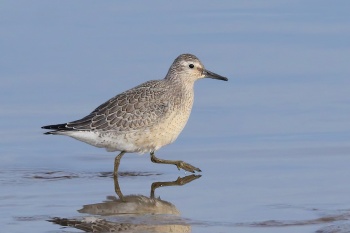- Calidris canutus
Identification
Length 23–26 cm (9-10¼ in), wingspan 47–53 cm, weight 85–220 g
- Black bill
- Olive-green legs
Summer
Brick-red to orangey-chestnut head and breast; black, orange and grey spangled upperparts, white under-tail coverts and grey wings with a light bar and dark tips
Winter
Reddish parts become plain grey above and white below; pale grey rump obvious in flight
Juvenile
Similar to adult winter, but upperpart feathers fringed with narrow dark inner and pale outer fringes, giving a scalloped pattern
Subadult
Similar to adult winter; one-year-old birds do not develop summer plumage, and typically remain on the wintering grounds through their first summer
Distribution

Photo © by Rodrigo Conte
Aruba, Caribbean; 21 September 2014
Breeds in the high Arctic of Russia, Alaska, Canada, and Greenland; rarely in the Western Palearctic but there are old breeding records for Svalbard.
A passage migrant and winter visitor to many of the World's coasts; rare inland but will use large freshwater lakes on passage.
For the main wintering areas, see for each subspecies below. Common on passage in the Baltic and on northwest European coasts in July to September, with smaller numbers again in May.
Vagrant to various Cyprus and the Near East countries, Madeira and Cape Verde Islands. Vagrant or rare but regular winter visitor to the Azores.
Taxonomy
Most closely related to the Great Knot - Surfbird species pair.
Subspecies

Photo © by Joe52
Bournemouth, Dorset, August 2018
There are six subspecies, eastwards from the Greenwich meridian[1]:
- C. c. canutus
- Breeds northwest Siberia (Taimyr Peninsula & Severnaya Zemlya), migrates via north and west Europe to the Atlantic coast of west Africa south to South Africa
- C. c. piersmai
- C. c. rogersi
- Breeds northeast Siberia (Chukotskiy Peninsula & Wrangel Island), migrates via Korea to the Pacific Ocean coast of Australia and New Zealand
- C. c. roselaari
- Breeds Alaska, migrates via western North America to the southwestern Caribbean
- C. c. rufa
- Breeds north-central Canada, migrates via southeastern United States (some also wintering) to southern South America; has also been reported from Britain
- C. c. islandica
The subspecies differ slightly in size (C. c. piersmai smallest, C. c. roselaari largest), and in the intensity of the summer plumage colours. They cannot be separated in winter or juvenile plumages; their wintering ranges are known from ringing studies. In Britain, two subspecies occur, but at different times of year, with C. c. canutus on passage in late summer and late spring, and C. c. islandica wintering from late autumn until early spring.
Habitat
Breeds in, sparsely vegetated foothills and high, rocky plateaux. On passage and in winter found on sandy and muddy shores, on wide estuaries and mudflats. Also on shingle beaches and sometimes on coastal grassland.
Behaviour
Diet
Their diet consists mostly of insects, such as worms, beetles, spiders, bees, snails and small crustaceans.
Breeding
Three to four eggs are laid in a shallow lined scrape. They are incubated by both adults. The male tends the young until they fledge.
Vocalisation
Gallery
Click on photo for larger image
C. c. piersmai, pre-breeding adult
Photo © by Dave Irving
Watzuwei Nature Reserve, Taiwan; 13 May 2013C. c. rogersi, adults moulting into summer plumage
Photo © by flossiepip
Waipu, Northland, New Zealand; 8 March 2013Winter adult, presumed C. c. islandica by location & date
Photo © by targetman
Lincolnshire coast, UK; March 2010Adult, C. c. roselaari
Photo © by jmorlan
Redwood City, California, USA, 18 April, 2023
References
- Clements, J. F., T. S. Schulenberg, M. J. Iliff, T. A. Fredericks, J. A. Gerbracht, D. Lepage, S. M. Billerman, B. L. Sullivan, and C. L. Wood. 2022. The eBird/Clements checklist of Birds of the World: v2022. Downloaded from https://www.birds.cornell.edu/clementschecklist/download/
- Collins Pocket Guide to British Birds 1966
- Handbook of the Birds of the World Alive (retrieved Aug 2018)
Recommended Citation
- BirdForum Opus contributors. (2025) Red Knot. In: BirdForum, the forum for wild birds and birding. Retrieved 1 May 2025 from https://www.birdforum.net/opus/Red_Knot
External Links
GSearch checked for 2020 platform.1










